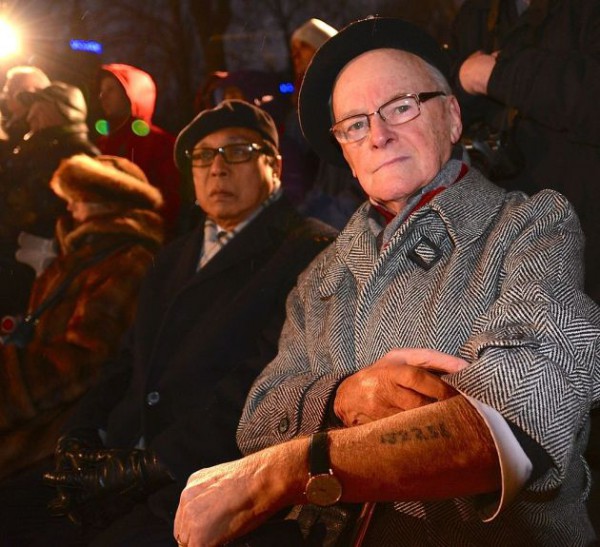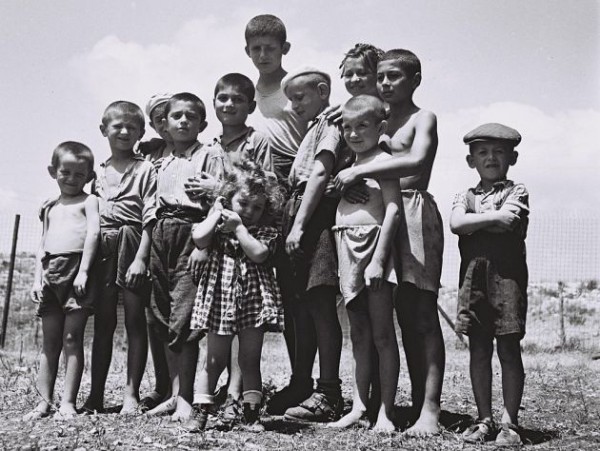“Hear my prayer, Lord; let my cry for help come to You…. In my distress I groan aloud and am reduced to skin and bones.” (Psalm 102:1, 5)
Today is Yom HaZikaron laShoah ve-laG’vurah (Holocaust and Heroism Remembrance Day), which is also known as Yom HaShoah or Holocaust Remembrance Day.
Although the Knesset (Israeli Parliament) set the date for this Israeli day of remembrance in 1951, Yom HaShoah has become an international day of mourning, and it is now commemorated throughout the world.
Here in Israel, it is a national day of mourning for the genocide of the Jewish People in Europe and the resistance fighters who stood up to the Nazis.
Last night at sunset and again this morning at 10 a.m., in cities and communities throughout Israel, men, women, and children of all ages will stand at attention as the woeful cry of the sirens blast throughout the farthest reaches of the country, reminding us of the catastrophic number of Jewish dead in the Shoah (Holocaust).
For two minutes the entire nation stood in silence in honor of the six million who were slaughtered by the Nazis and their collaborators.
At a previous Yom HaShoah state ceremony at Yad VaShem (Holocaust Memorial Museum) in honor of the six million who perished in the Holocaust, Israeli Prime Minister Benjamin Netanyahu stated:
“Why, in the years preceding the Holocaust, did the overwhelming majority of world leaders and Jewish leaders fail to detect the danger in time? In retrospect, all the warning signs were there: the strengthening of the Nazi regime year after year; the horrific anti-Semitic propaganda which grew stronger with each passing month; and the murderous attacks on Jews which began as a trickle and transformed into a huge wave.
“The bitter and tragic truth is this: it is not that they did not see it. They did not want to see it. And why did they choose not to see the truth? Because they did not want to face the consequences of that truth.”
A Knesset law passed in 1959 obligates citizens to recognize the victims of the Shoah and ghetto uprisings in public observance on this day.
Programs are organized throughout the country in which survivors tell their stories, and both radio and TV programming is totally devoted to testimonies of survivors, as well as films depicting the atrocities.
Even musical programs spotlight the theme of human suffering, maintaining the Yom HaShoah atmosphere. Throughout the country, all theaters, cafes, movie houses and other forms of entertainment are closed.
This effort by the government has done much to educate the population regarding the sufferings of the survivors, which extend beyond the Holocaust itself.
The Shoah and Its After-Effects
Survivors have suffered not only from the effects of the Shoah itself, but in many cases from its aftereffects.
Many who returned to their homes following life in the camps were met with pogroms (organized violence) and often killed.
This occurred mostly in eastern European countries, such as Poland where their property had been taken from them. Those who had taken that property, or purchased it from those had taken it, were determined to keep it.
A great number of survivors found themselves as refugees in displaced persons camps. Others suffered the rigors of illegal immigration into pre-state Israel.

A Holocaust survivor views a pile of bodies stacked in a shed in the Ohrdruf concentration camp in Germany. Approximately two thirds of Europe’s nine million Jews were murdered in the Holocaust.
This led in many cases to a form of Konzentration Lager (German for concentration camp) Syndrome that is similar to many of the symptoms today associated with Post-Traumatic Stress Disorder (PTSD).
For example, several studies following the war showed that survivors demonstrated higher scores on the index of emotional distress than comparable groups.
In a study that was carried out in Israel and published in 2009 in the British Journal of Psychiatry, it was found that anxiety disorders, emotional distress and sleep disturbances were more frequent among Holocaust survivors than among a comparable group.
The years since the Holocaust have remained challenging for survivors who deal with both emotional and mental scars, in addition to economic woes.

In the Auschwitz concentration camp complex, incoming prisoners who were selected to work were tattooed with a serial number. Those who were sent directly to the gas chambers were not issued serial numbers and therefore, not tattooed.
During and after the Holocaust, some of the few remaining victims made it to Israel in the midst of its rebirth as an independent, modern-day state.
Just hours after their arrival, many of them died while fighting for the survival of the new nation in the battle for a British police fort that had been turned over to the Arabs—Latrun.
The Haganah (original Israeli military force from 1920–1948) formed a new unit, the 7th Brigade, which consisted mostly of Holocaust survivors, some of whom had never fired a weapon.
They were given the task of taking the fort in order to break the blockade of Jerusalem held by Jordan’s Arab Legion.
At that time, 20-year-old Ariel “Arik” Sharon, who still went by the name of Scheinerman, commanded the 1st Platoon of B Company of the 32nd Battalion, the only fighting force to have previously seen battle.
In a letter written by Sharon to his parents before the battle, he describes a convoy of fresh troops arriving in the olive grove where they awaited orders to attack.
“Suddenly a convoy of trucks stopped next to us and unloaded new, foreign-looking recruits,” writes Sharon.
“They looked slightly pale, and were wearing sleeveless sweaters, gray pants, and striped shirts. A stream of languages filled the air, names like Herschel and Yazek, Jan and Maitek were thrown around. They stuck out against the backdrop of olives, rocks, and yellowing grains. They’d come to us through blocked borders, from Europe’s death camps.”
He chronicles how they fumbled with their new uniforms, trying to suit up.
“They did this in silence, as though they had made their peace with fate. Not one of them cried out: ‘Let us at least breathe the free air after the years of terrible suffering.’ It is as if they’d come to the conclusion that this is one final battle for the future of the Jewish people.”
At five in the morning, Sharon led his troops out of the olive grove and into a blaze of withering fire. By one that afternoon, half of his platoon was dead and most of the others were wounded.
When Sharon was shot in the abdomen, another wounded soldier dragged him to safety.
Later in the afternoon, Sharon’s unit was cut off and surrounded as the rest of the brigade retreated, leaving many wounded in the field who were butchered by the surrounding Palestinian villagers. (Times of Israel)
Born in 1928 in pre-state Israel, Ariel Sharon participated in most of the crucial moments in modern Israel’s creation, defense, and leadership. He passed away in January, 2014.
The Remarkable Resilience of Holocaust Survivors
“Comfort, comfort My people, says your God. Speak tenderly to Jerusalem and proclaim to her that her hard service has been completed, that her sin has been paid for, that she has received from the Lord’s hand double for all her sins.” (Isaiah 40:1–2)
Pogroms, loss of property, and war against the Jews in Israel were not the only ways survivors suffered: they were looked down upon even in Israel.
Initially, they were viewed as weak, since they “allowed themselves” to become victims.
To combat this form of ignorance, Israel introduced curricula in the education system that emphasized the sufferings inflicted on millions of European Jews during World War II.
Still, surveys from the late 50s showed that Israeli youth were not sympathetic toward Holocaust victims, believing that they had been “led like sheep to the slaughter.”
In response, Israel’s curriculum began to show that European Jews maintained their humanity under unbearable conditions. They had resisted the Nazis through passive resistance, as well as through active resistance by fighting them in ghettos and joining with partisans who resisted the Third Reich in the occupied countries.

The motto of the Fareynikte Partizaner Organizatsye (FPO/ United Partisan Organization), a Jewish resistance organization based in the Vilna Ghetto, was “We will not allow them to take us like sheep to the slaughter.”
Although it is true that surviving the Holocaust brings with it many challenges to life in general, a current study by researchers at the University of Haifa and Leiden University (the Netherlands) reveals that men who survived the Holocaust live longer than a similar group that did not go through the war.
The study examined 55,000 Polish Jewish men who immigrated to Israel before and after World War II.
Under the direction of Professor Avi Sagi-Schwartz of the University of Haifa’s psychology department and head of its Center for the Study of Child Development, the study found that the drive to survive among those that made it through seems to have resulted in a longer life expectancy.
Sagi-Schwartz said, “Holocaust survivors not only suffered grave psychosocial trauma but also famine, malnutrition, and lack of hygienic and medical facilities, leading us to believe these damaged their later health and reduced life expectancy.” (JPost)

Eight-year-old Yisrael Meir (Lulek) Lau is held by a fellow Buchenwald survivor, Elazar Schiff, as they arrive in Palestine Israel aboard the RMS “Mataroa.”
But that may not be the case.
According to Sagi-Schwartz, “Men who were 10 to 15 years old during the war and in their early adolescence showed a 10-months-longer life expectancy than the comparison group.
Men who lived through the Holocaust when they were 16 to 20 showed an even greater difference in life expectancy—18 months longer—than their peers who didn’t experience the Holocaust.”
The researchers believe that the psychological stress suffered by survivors following the war may have served as a stimulus for the development of personal and interpersonal skills and helped them to gain greater insight into the meaning of life.
All of this, they argue, may have also contributed to their greater longevity.
“The results of this research give us hope and teach us quite a bit about the resilience of the human spirit when faced with brutal and traumatic events,”Sagi-Schwartz concluded. (JPost)
Tough Living Conditions in Israel
Approximately 145,000 survivors, at an average age of 85, currently live in Israel.
More than a third live below the poverty line, according to the Foundation for the Benefit of Holocaust Victims in Israel.
With 1,000 passing away each month, it is estimated that all Holocaust survivors will have departed by 2030.
Increasingly, these Holocaust survivors need financial and nursing assistance.
While non-profits exist and government assistance is available, Israel’s State Comptroller recently published a report that shows millions of shekels allocated to survivors have not been dispersed.
As well, they found that survivors have difficulty navigating websites and the government system to take advantage of their rights.
While we commemorate Holocaust Remembrance Day, let us also focus our hearts on helping those in need today.
“Of course it’s profoundly important that we remember and memorialize the past. But we must also fulfill our moral obligation to the dwindling number of survivors who are living in the most unspeakable poverty,” said Rabbi Eckstein of the International Fellowship of Christians and Jews.
“We must do whatever we can, while we still can, to bring compassion to those who endured one of the most horrific periods in our history. Sadly we are not. Instead of giving tens of millions of dollars for Shoah museums, testimonial libraries and the like, we ought to also focus on helping provide for these desperately poor Jews in the few years they are still alive.” (Arutz Sheva)




















